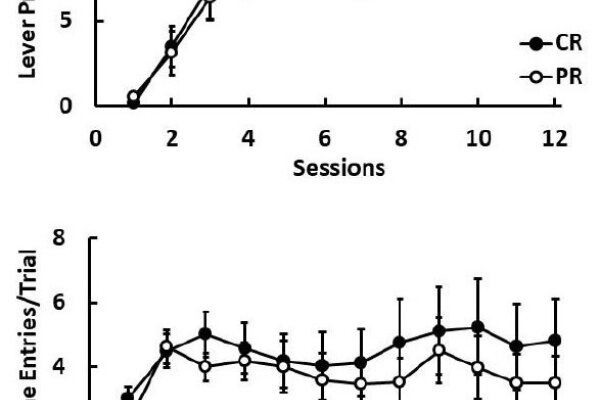2021-03-22

In Pavlovian autoshaping, sign-tracking responses (lever pressing) to a conditioned stimulus (CS) are usually invigorated under partial reinforcement (PR) compared to continuous reinforcement (CR). This effect, called the PR acquisition effect (PRAE), can be interpreted in terms of increased incentive hope or frustration-induced drive derived from PR training. Incentive hope and frustration have been related to dopaminergic and GABAergic activity, respectively. We examined the within-trial dynamics of sign and goal tracking in rats exposed to 20-s-long lever presentations during autoshaping acquisition under PR vs. CR conditions under the effects of drugs tapping on dopamine and GABA activity. There was no evidence of the PRAE in these results, both groups showing high, stable sign-tracking response rates. However, the pharmacological treatments affected behavior as revealed in within-trial changes. The dopamine D2 receptor agonist pramipexole (0.4 mg/kg) suppressed lever pressing and magazine entries relative to saline controls in a within-subject design, but only in PR animals. The allosteric benzodiazepine chlordiazepoxide (5 mg/kg) failed to affect either sign or goal tracking in either CR or PR animals. These results emphasize the roles of dopamine and GABA receptors in autoshaping performance, but remain inconclusive with respect to incentive hope and frustration theories. Some aspects of within-trial changes in sign and goal tracking are consistent with a mixture of reward timing and response competition.

In Pavlovian autoshaping, sign-tracking responses (lever pressing) to a conditioned stimulus (CS) are usually invigorated under partial reinforcement (PR) compared to continuous reinforcement (CR). This effect, called the PR acquisition effect (PRAE), can be interpreted in terms of increased incentive hope or frustration-induced drive derived from PR training. Incentive hope and frustration have been related to dopaminergic and GABAergic activity, respectively. We examined the within-trial dynamics of sign and goal tracking in rats exposed to 20-s-long lever presentations during autoshaping acquisition under PR vs. CR conditions under the effects of drugs tapping on dopamine and GABA activity. There was no evidence of the PRAE in these results, both groups showing high, stable sign-tracking response rates. However, the pharmacological treatments affected behavior as revealed in within-trial changes. The dopamine D2 receptor agonist pramipexole (0.4 mg/kg) suppressed lever pressing and magazine entries relative to saline controls in a within-subject design, but only in PR animals. The allosteric benzodiazepine chlordiazepoxide (5 mg/kg) failed to affect either sign or goal tracking in either CR or PR animals. These results emphasize the roles of dopamine and GABA receptors in autoshaping performance, but remain inconclusive with respect to incentive hope and frustration theories. Some aspects of within-trial changes in sign and goal tracking are consistent with a mixture of reward timing and response competition.